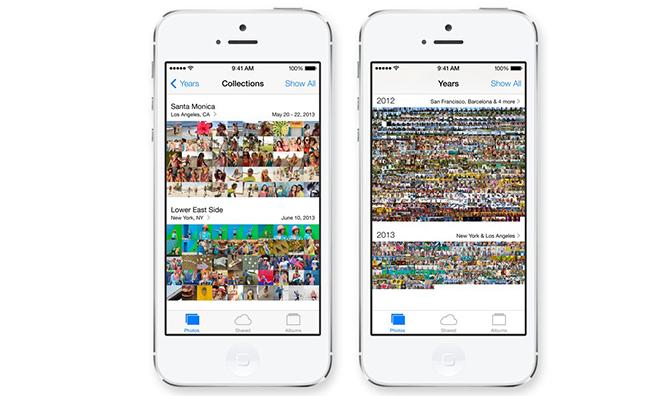The popularity of Apple's iPhone has made the Cupertino company a de facto leader in the camera segment, and Monday's WWDC keynote demonstrated that photography will remain a focus in iOS going forward.
"Your camera in iOS 7 is four cameras in one," said Craig Federighi, Apple's software engineering head, during a segment of the keynote devoted to overhauled Camera and Photo apps. Federighi went on to demonstrate a number of new tweaks and features Apple has added to iOS' picture capture and storage functions that boost the system well beyond what is currently capable on Apple devices.
With iOS 7, iPhone 5 owners — as well as the owners of the iPhone 5's successor — will gain the ability to edit photos with filters built directly into the Camera app. Within the camera app, the new feature will give users access to nine image types before they take the picture, much like the functionality that has made third-party apps like Instagram so popular. Owners of the iPhone 4 or 4S will have the ability to apply filters after the fact within the Photos app.
Users will also have the option to swipe between camera modes, eliminating one layer of complexity in iOS' interface. The OS update will add the ability to swipe between video, panorama shots, standard still shots, and squared-off shots, with an indicator near the bottom of the screen providing assistance in navigating between options.
In addition to the new Camera features, Apple has significantly reworked its Photo storage app. Whereas previous editions saw largely cosmetic changes — such as the ability to pinch and zoom into "stacks" of photos — the forthcoming makeover appears to have been designed with an eye toward increasing utility.
The new Photos app leverages metadata tagging technology already built into the iPhone in order to easily organize photos. Pictures are now automatically grouped according to date and location, making it easier to navigate to a specific photo set and subsequently find a desired photo.
Pinching a set closed will expand to view a wider time frame, with photos categorized in miniature by the year in which they were taken. This year view still retains location information, showing two or three locations and indicating when more places were included in a given year.
Notably, Apple included an option to "scrub" to a particular picture or time frame when in the year view by touching and dragging along the tiny icons. When passing over a picture, it expands, giving the user a better view of which image it is.
Apple also showed off new iCloud photo sharing features, including new support for video sharing in photo streams. The service also now has an Activity view that allows users to see the latest updates from all of their shared streams in one place.
A number of Apple's new photo features have precedents in devices made by rival manufacturers, but the Cupertino company's moves to further improve its camera functions demonstrates the seriousness with which it approaches that portion of the smartphone experience. The iPhone is the most popular picture-taking device in the world, and Apple does not hesitate to point this out.
 Kevin Bostic
Kevin Bostic







-m.jpg)






 Charles Martin
Charles Martin


 Wesley Hilliard
Wesley Hilliard
 Stephen Silver
Stephen Silver
 William Gallagher
William Gallagher

 Marko Zivkovic
Marko Zivkovic








6 Comments
I have questions. Hopefully some of you can answer. Do you apply the filters before or after taking the photo? If it's before is there a way to get back the original image? If after does it save the filtered photo as a new photo? Also if after, do you have to go in manually, select the photo and then filter it or does it prompt you to filter it after the photo is taken? The latter could be annoying if you're trying to shoot multiple photos one after another quickly. I am a 4S user. So when shooting photos or videos the rations displayed on screen is the same. However I notice that the ratio shown in iOS 7 takes up the whole screen for shooting video and only part of the screen when shooting standard stills. So what is the actual aspect ratio of the camera sensor itself? I would hate for them to be cropping from a 16:9 sensor to give me stills as a ratio of 4:3. Hope that the iPhone 5S allows us to shoot photos in raw. That would be cool.
Photo Stream. Now with video. I like it. Needed it, actuall. After they EOL-ed Galleries I resorted to Phanfare because they dropped Galleries before launching Photo Stream. But that software is so poor at posting video I am really going to like PS with video support. [quote name="ApplePi" url="/t/157957/apple-focuses-on-sharing-lifes-moments-with-new-ios-7-camera-and-photo-features#post_2342954"]I have questions. Hopefully some of you can answer. Do you apply the filters before or after taking the photo? If it's before is there a way to get back the original image? If after does it save the filtered photo as a new photo? Also if after, do you have to go in manually, select the photo and then filter it or does it prompt you to filter it after the photo is taken? The latter could be annoying if you're trying to shoot multiple photos one after another quickly. I am a 4S user. So when shooting photos or videos the rations displayed on screen is the same. However I notice that the ratio shown in iOS 7 takes up the whole screen for shooting video and only part of the screen when shooting standard stills. So what is the actual aspect ratio of the camera sensor itself? I would hate for them to be cropping from a 16:9 sensor to give me stills as a ratio of 4:3. Hope that the iPhone 5S allows us to shoot photos in raw. That would be cool. [/quote] I presume you apply the filter afterwards and gets saved as a new version. As for the AR, the original iPhone had a 3:2 screen with a 4:3 image sensor. That made it a terrible experience because you would not see everything and made compositing an image very difficult. You can easily see what I mean if you open a photo taken with you iPhone and then pinch to zoom out; there's more to see than what the photo app is showing you when flikking through. It hasn't gotten any better with the 1136*640 as the sensor is still 4:3. Oh, and RAW? Eh, no. Especially not for people with an 8GB model. For this, grab your SLR.
Photo Stream. Now with video.
Does this mean it will backup to iPhoto automatically? That is the longest part of the "backup" process while I'm making additional storage room.
Additionally- I'm curious if it will make its way to Apple TV's "Photostream".
[quote name="Andysol" url="/t/157957/apple-focuses-on-sharing-lifes-moments-with-new-ios-7-camera-and-photo-features#post_2343350"][QUOTE name="PhilBoogie" url="/t/157957/apple-focuses-on-sharing-lifes-moments-with-new-ios-7-camera-and-photo-features#post_2343147"] Photo Stream. Now with video. [/QUOTE] Does this mean it will backup to iPhoto automatically? That is the longest part of the "backup" process while I'm making additional storage room. Additionally- I'm curious if it will make its way to Apple TV's "Photostream". [/quote] I'm not a developer, so no access to the beta, presuming this can be tested. My assumption though is that it will: 1. auto sync once on WiFi, or 3G/LTE is you enable that 2. gets into your 30 days/1000 limit 'regular Photo Stream and will be available on your Mac, iPad, AppleTV and a web browser, if made public 3. I don't use iPhoto but Aperture. And that can sync all your photos and video the the application. I presume it's the same with iPhoto. I didn't quite understand why iCloud wouldn't sync video as well when we got it. But maybe they needed to start off slowly with all these millions accounts and not know exactly how much storage they would need to offer the Photo Stream service. Looks like they've build enough data centers to hold video now as well. Personally I get the videos I take off my iPhone through Image Capture.app. For the life of me I cannot figure out why I cannot use iTunes to sync photo's and video; it was designed the be the hub, remember?
I do. I use Aperture for it as well. That's really the only time I plug my phone in- to take videos off. I'd like two things- 1- it automatically saves my videos, so I won't have to plug in. And 2- it has an easier option to delete (so i dont have to delete individually). Currently- after I plug in, it transfers, then it asks to delete. If I dont want to plug in ever again, the deleting thing would have to be easier than current. Either way, it's not the end of the world, just a "small want".